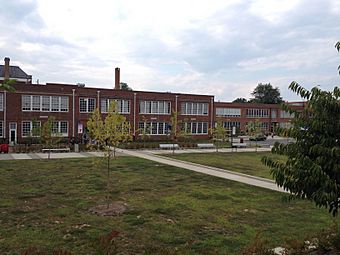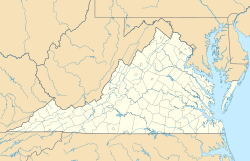Jefferson School (Charlottesville, Virginia) facts for kids
|
Jefferson School, Carver Recreation Center, and School Site
|
|
 |
|
| Location | 233 Fourth St., NW, Charlottesville, Virginia |
|---|---|
| Area | 4 acres (1.6 ha) |
| Built | 1926, 1938-39, 1958, 1959 |
| Architect | Calrow, Browne, and Fitz-Gibbons |
| NRHP reference No. | 06000050 |
Quick facts for kids Significant dates |
|
| Added to NRHP | February 15, 2006 |
The Jefferson School is an important historic building in Charlottesville, Virginia, United States. It was first built to be a high school for African-American students during a time when schools were separated by race.
The school is a large, two-story brick building. It was built in different parts, starting in 1926. More sections were added in 1938–39, 1958, and 1959. The 1938–1939 addition even got some money from a government program called the Public Works Administration (PWA).
From 1926 to 1951, this building was Charlottesville's first high school for black students. After that, it became an elementary school for black students. In 1958, students from Jefferson School wanted to go to schools that were only for white students. This led the city to join a statewide movement against school integration.
Over the years, the building was used for many different things. In 2013, it reopened as the Jefferson School City Center. Today, it's a busy place that includes the Jefferson School African American Heritage Center, the Carver Recreation Center, and other community groups.
Contents
Jefferson High School (1926-1951)
The Jefferson School opened as a high school in 1926. This happened after people in the community asked the Charlottesville City Council to create a high school for black students. Before this, black students went to the Jefferson Colored/Graded Elementary School, which only went up to eighth grade.
At the time, Jefferson High School was one of only six accredited high schools for black students in Virginia. In the 1937–1938 school year, 68 freshmen started at the school. By their final year (1940–1941), 40 of those students returned to graduate.
In 1943, the school had 14 teachers and was led by Principal Owen J. Duncan, Jr. That year, 54 seniors graduated. In the 1950–1951 school year, 335 students were enrolled in grades 7 to 11.
Student Life and Activities
Before the high school closed in 1951, students had many activities. There was a football team for boys and basketball teams for both boys and girls. Students could also join clubs like the French Club, Dramatics Club, School Band, Science Club, and Glee Club.
The Dramatics Club was very popular in the 1944–45 school year, with 114 student members. The school newspaper was called The Jeffersonian. It had different sections, including sports, features, and even advertising. In 1945, all the senior class officers were women for the first time ever. A famous person who went to Jefferson High School was football player Rosey Brown.
The Music Department at Jefferson High School was very active in 1941. It had a school band and three singing groups: the girls' glee club, an all-male chorus called the Singing Privateers, and a mixed chorus of 60 voices. The school band often performed for churches, schools, and clubs. In May 1941, they even played at the Paramount Theater. By 1945, the band traveled with the football team to perform at games in Richmond.
In 1951, a new school called Burley High School opened nearby. It was built to serve students from Jefferson and other black high schools in the area.
School Yearbooks
The yearbook for Jefferson High School was named the Crimson and Black. By the 1944–1945 school year, it had a staff of 18 students.
The 1944 yearbook was dedicated to the students who had joined the armed forces. It honored them for serving the country and working to bring lasting peace.
Community Library
In 1934, a library opened at the Jefferson School. It was for both students and the public to use. The Charlottesville City Council started this project so that the black community would have access to a library.
Jefferson Elementary School (1951-1965)
Starting in 1951, the Jefferson School became an elementary school. It served black students up to the eighth grade. In 1958, the NAACP (National Association for the Advancement of Colored People) filed a lawsuit. This lawsuit was on behalf of Jefferson School students who wanted to transfer to nearby schools that were only for white students.
Integrated Middle School (1965-1967)
From 1965 to 1966, the Jefferson School was used for Charlottesville's 7th, 8th, and 9th-grade students. The City School Board had planned to open two new junior high schools in September 1965. However, construction delays meant these schools were not ready.
So, students for the new Walker Junior High School went to Jefferson in the mornings. Students for the new Buford Junior High School went to Jefferson in the afternoons. The next school year, 1966-1967, Walker and Buford opened. Jefferson then housed all Charlottesville sixth graders. This was part of an effort, supported by the NAACP, to fully integrate Charlottesville's schools.
Historic Recognition
In 2005, people suggested that the Jefferson School building should be added to the National Register of Historic Places. It officially received this important designation in 2006.
There are two historical markers in Charlottesville that remember a special event. They honor "The Triumph of the Charlottesville Twelve." These were three students who integrated Lane High School and nine Jefferson School students who integrated Venable Elementary School. This happened on September 8, 1958, and caused those schools to close for a few days.



